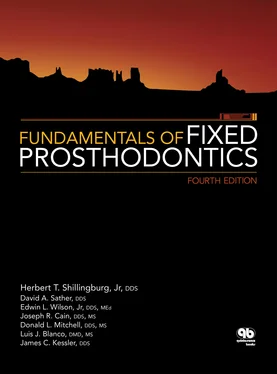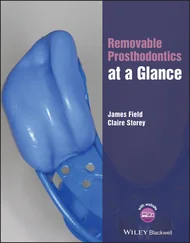Teeth that have been pulp capped in the process of preparation should not be used as fixed partial denture abutments unless they are endodontically treated. There is too great a risk that they will require endodontic treatment later, with the resultant destruction of retentive tooth structure and of the retainer itself. This is a situation that is better handled before the fixed partial denture is made.
The supporting tissues surrounding the abutment teeth must be healthy and free from inflammation before any prosthesis can be contemplated. Normally, abutment teeth should not exhibit mobility because they will be carrying an extra load. The roots and their supporting tissues should be evaluated for three factors:
1 Crown-root ratio
2 Root configuration
3 Periodontal ligament area
The crown-root ratio is a measure of the length of tooth occlusal to the alveolar crest of bone compared with the length of root embedded in the bone. As the level of the alveolar bone moves apically, the lever arm of the portion out of bone increases, and the chance for harmful lateral forces increases. The optimum crown-root ratio for a tooth to be used as a fixed partial denture abutment is 2:3; a ratio of 1:1 is the maximum ratio that is acceptable for a prospective abutment under normal circumstances ( Fig 7-5).
However, there are situations in which a crown-root ratio greater than 1:1 might be considered adequate. If the occlusion opposing a proposed fixed partial denture is composed of artificial teeth, occlusal force will be diminished, with less stress on the abutment teeth. The occlusal force exerted against prosthetic appliances has been shown to be considerably less than that against natural teeth: 26.0 lbs for removable partial dentures and 54.5 lbs for fixed partial dentures versus 150.0 lbs for natural teeth. 1
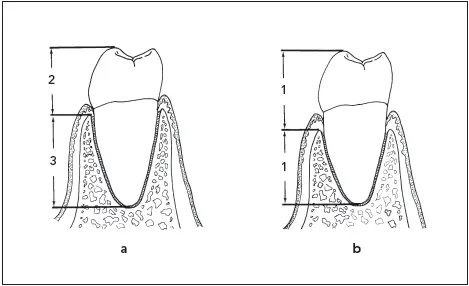
Fig 7-5 (a) The optimum crown-root ratio for a fixed partial denture abutment is 2:3. (b) A ratio of 1:1 is the maximum that is acceptable.

Fig 7-6Although the root surface area of these teeth is similar, the root configuration of the maxillary premolar ( a ), with its greater faciolingual dimension, makes it a superior abutment to the maxillary central incisor ( b ), whose root is essentially circular in cross section.
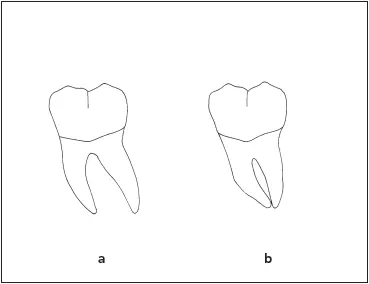
Fig 7-7The molar with divergent roots (a) will be a better abutment tooth than one whose roots are fused (b) .
For the same reasons, an abutment tooth with a less-than- desirable crown-root ratio is more likely to successfully support a fixed partial denture if the opposing occlusion is composed of mobile, periodontally involved teeth than if the opposing teeth are periodontally sound. The crown-root ratio alone is not an adequate criterion for evaluating a prospective abutment tooth. 2
Root configuration is an important part of the assessment of an abutment’s suitability from a periodontal standpoint. Roots that are broader labiolingually than they are mesiodistally are preferable to roots that are round in cross section ( Fig 7-6). Multirooted posterior teeth with widely separated roots will offer better periodontal support than roots that converge, fuse, or generally present a conical configuration ( Fig 7-7). The tooth with conical roots can be used as an abutment for a short-span fixed partial denture if all other factors are optimal. A single-rooted tooth with evidence of irregular configuration or with some curvature in the apical third of the root is preferable to the tooth that has a nearly perfect taper.
Periodontal ligament area
Another consideration in the evaluation of prospective abutment teeth is the root surface area, or the area of periodontal ligament attachment of the root to the bone. Larger teeth have a greater surface area and are better able to bear added stress. The areas of the root surfaces of the various teeth have been reported by Jepsen 3and are shown in Figs 7-8 and 7-9. The actual values are not as significant as the relative values within a given mouth and the ratios between the various teeth in one arch. When supporting bone has been lost because of periodontal disease, the involved teeth have a lessened capacity to serve as abutments. Millimeter per millimeter, the loss of periodontal support from root resorption is only one-third to one-half as critical as the loss of alveolar crestal bone. 4The planned treatment should take this into account.
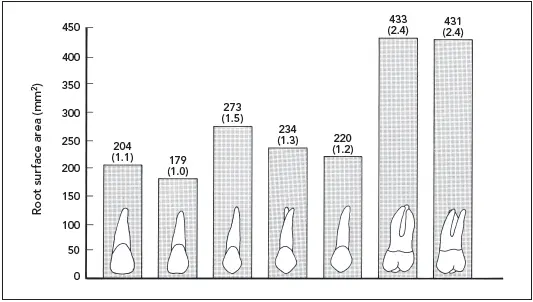
Fig 7-8Comparative root surface areas of maxillary teeth. The number in parentheses above each tooth is the ratio between the root surface area of the respective tooth and the root surface area of the smallest tooth in the arch, the lateral incisor (based on data by Jepsen 3).
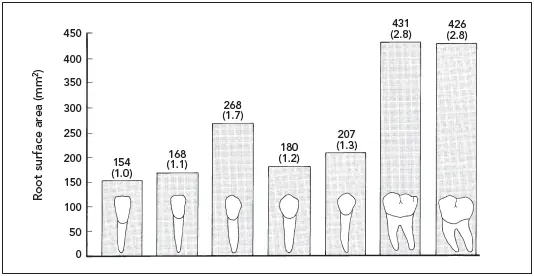
Fig 7-9Comparative root surface areas of mandibular teeth. The number in parentheses above each tooth is the ratio between the root surface area of the respective tooth and the root surface area of the smallest tooth in the arch, the central incisor (based on data by Jepsen 3).
The length of the pontic span that can be successfully restored is limited in part by the abutment teeth and their ability to accept the additional load. Traditionally, there has been general agreement on the number of missing teeth that can be restored successfully. Tylman stated that two abutment teeth could support two pontics. 5In a statement designated as Ante’s Law by Johnston et al, 6the root surface area of the abutment teeth had to equal or surpass that of the teeth being replaced with pontics. 7
According to this premise, one missing tooth can be successfully replaced if the abutment teeth are healthy ( Fig 7-10). If two teeth are missing, a fixed partial denture probably can replace the missing teeth, but the limit is being approached ( Fig 7-11). When the root surface area of the teeth to be replaced by pontics surpasses that of the abutment teeth, a generally unacceptable situation exists ( Fig 7-12).
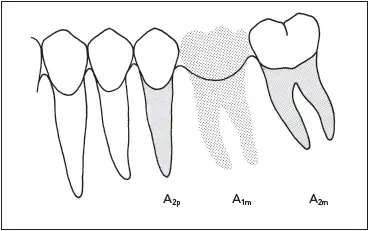
Fig 7-10The combined root surface area of the second premolar and the second molar (A 2p+ A 2m) is greater than that of the first molar being replaced (A 1m).
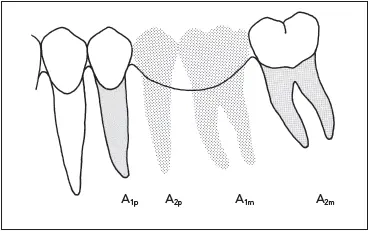
Fig 7-11The combined root surface area of the first premolar and the second molar abutments (A 1p+ A 2m) is approximately equal to that of the teeth being replaced (A 2p+ A 1m).
Читать дальше
